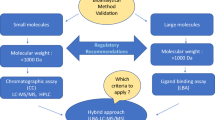ABSTRACT
There are many sources of analytical variability in ligand binding assays (LBA). One strategy to reduce variability has been duplicate analyses. With recent advances in LBA technologies, it is conceivable that singlet analysis is possible. We retrospectively evaluated singlet analysis using Gyrolab data. Relative precision of duplicates compared to singlets was evaluated using 60 datasets from toxicokinetic (TK) or pharmacokinetic (PK) studies which contained over 23,000 replicate pairs composed of standards, quality control (QC), and animal samples measured with 23 different bioanalytical assays. The comparison was first done with standard curve and QCs followed by PK parameters (i.e., Cmax and AUC). Statistical analyses were performed on combined duplicate versus singlets using a concordance correlation coefficient (CCC), a measurement used to assess agreement. Variance component analyses were conducted on PK estimates to assess the relative analytical and biological variability. Overall, 97.5% of replicate pairs had a %CV of <11% and 50% of the results had a %CV of ≤1.38%. There was no observable bias in concentration comparing the first replicate with the second (CCC of 0.99746 and accuracy value of 1). The comparison of AUC and Cmax showed no observable difference between singlet and duplicate (CCC for AUC and Cmax >0.99999). Analysis of variance indicated an AUC inter-subject variability 35.3-fold greater than replicate variability and 8.5-fold greater for Cmax. Running replicates from the same sample will not significantly reduce variation or change PK parameters. These analyses indicated the majority of variance was inter-subject and supported the use of a singlet strategy.








Similar content being viewed by others
REFERENCES
Yalow RS, Berson SA. Immunoassay of endogenous plasma insulin in man. J Clin Invest. 1960;39(7):1157–75.
Wu AHB. A selected history and future of immunoassay development and applications in clinical chemistry. Clin Chim Acta. 2006;369(2):119–24.
Banks P. The microplate market past, present and future microplates today—the global market. Drug Discovery World Spring 2009
DeSilva B, Smith W, Weiner R, Kelley M, Smolec J, Lee B, et al. Recommendations for the bioanalytical method validation of ligand-binding assays to support pharmacokinetic assessments of macromolecules. Pharm Res. 2003;20(11):1885–900.
DeSilva B, Garofolo F, Rocci M, Martinez S, Dumont I, Landry F, et al. 2012 White paper on recent issues in bioanalysis and alignment of multiple guidelines. Bioanalysis. 2012;4(18):2213–26.
Hottenstein CS, Becker C, Asher C, Coleman J, Evans CA. Variance component analysis of singlicate versus duplicate ligand binding assay performance of a single bioanalytical method. Poster at AAPS NBC 2015.
Hall CM, Pearson JT, Patel V, Wienkers LC, Greene RJ. An extended range generic immunoassay for total human therapeutic antibodies in preclinical pharmacokinetic studies. J Immunol Methods. 2013;31(393):70–3.
Roman J, Qiu J, Dornadula G, Hamuro L, Bakhtiar R, Verch T. Application of miniaturized immunoassays to discovery pharmacokinetic bioanalysis. J Pharmacol Toxicol Methods. 2011;63(3):227–35.
Mora JR, Obenauer-Kutner L, Vimal PV. Application of the Gyrolab™ platform to ligand-binding assays: a user’s perspective. Bioanalysis. 2010;2(10):1711–5.
Verch T, Bakhtiar R. Miniaturized immunoassays: moving beyond the microplate. Bioanalysis. 2012;4(2):177–88.
Given AM, Whalen PM, O’Brien PJ, Ray CA. Development and validation of an alpha fetoprotein immunoassay using Gyros technology. J Pharm Biomed Anal. 2012;64–65:8–15.
Shih JY, Patel V, Watson A, Hager T, Luan P, Salimi-Moosavi H, et al. Implementation of a universal analytical method in early-stage development of human antibody therapeutics: application to pharmacokinetic assessment for candidate selection. Bioanalysis. 2012;4(19):2357–65.
Joyce AP, Wang M, Lawrence-Henderson R, Filliettaz C, Leung SS, Xu X, et al. One mouse, one pharmacokinetic profile: quantitative whole blood serial sampling for biotherapeutics. Pharm Res. 2014;31(7):1823–33.
Lin I-Kuei L. Measuring agreement (in Encyclopedia of Biopharmaceutical Statistics), 3rd edition, Shein-Chung Chow, editors. Informa Healthcare, London. 2010. p. 745-750
Lacey LF, Keene ON, Pritchard JF, Bye A. Common noncompartmental pharmacokinetic variables: are they normally or log-normally distributed? J Biopharm Stat. 1997;7(1):171–8.
Stevenson L, Amaravadi L, Myler H, Salazar-Fontana L, Gorovits B, Kirshner S, et al. 2014 White paper on recent issues in bioanalysis: a full immersion in bioanalysis (part 3—LBA and immunogenicity). Bioanalysis. 2014;6(24):3355–68.
Dudal S, Baltrukonis D, Crisino R, Goyal MJ, Joyce A, Osterland K, et al. Assay formats: recommendations for best practices and harmonization from the Global Bioanalytical Consortium Harmonization Team. AAPS J. 2014;16(2):194–205.
Booth B, Arnold ME, DeSilva B, Amaravadi L, Dudal S, Fluhler E, et al. Workshop report: crystal city V-quantitative bioanaytical method validation and implementation: the 2013 revised FDA guidance. AAPS J. 2015;17(2):227–88.
ACKNOWLEDGMENTS
The authors would like to acknowledge Boris Gorovits’s scientific review of this publication and appreciate the contributions that Greg Sjogren made to generating some of the data used in this retrospective analysis.
Author information
Authors and Affiliations
Corresponding author
ELECTRONIC SUPPLEMENTARY MATERIAL
Below is the link to the electronic supplementary material.
ESM 1
(DOCX 30 kb)
Rights and permissions
About this article
Cite this article
Clark, T.H., Yates, P.D., Chunyk, A.G. et al. Feasibility of Singlet Analysis for Ligand Binding Assays: a Retrospective Examination of Data Generated Using the Gyrolab Platform. AAPS J 18, 1300–1308 (2016). https://doi.org/10.1208/s12248-016-9944-8
Received:
Accepted:
Published:
Issue Date:
DOI: https://doi.org/10.1208/s12248-016-9944-8




